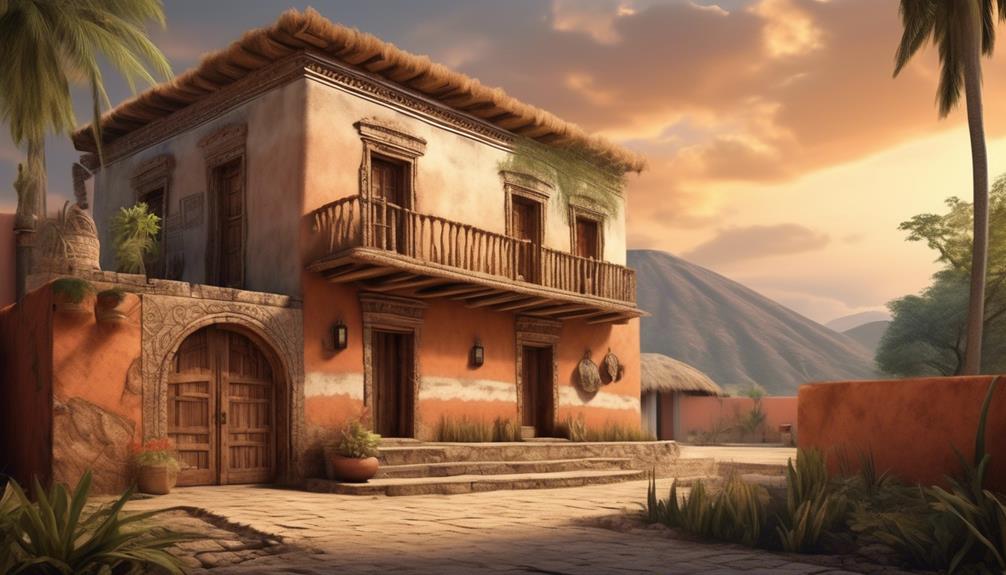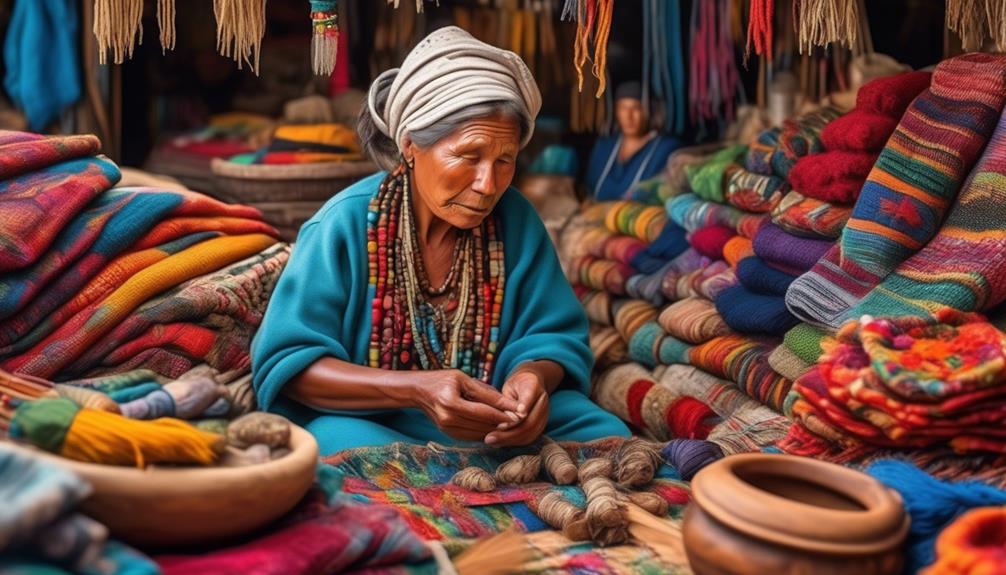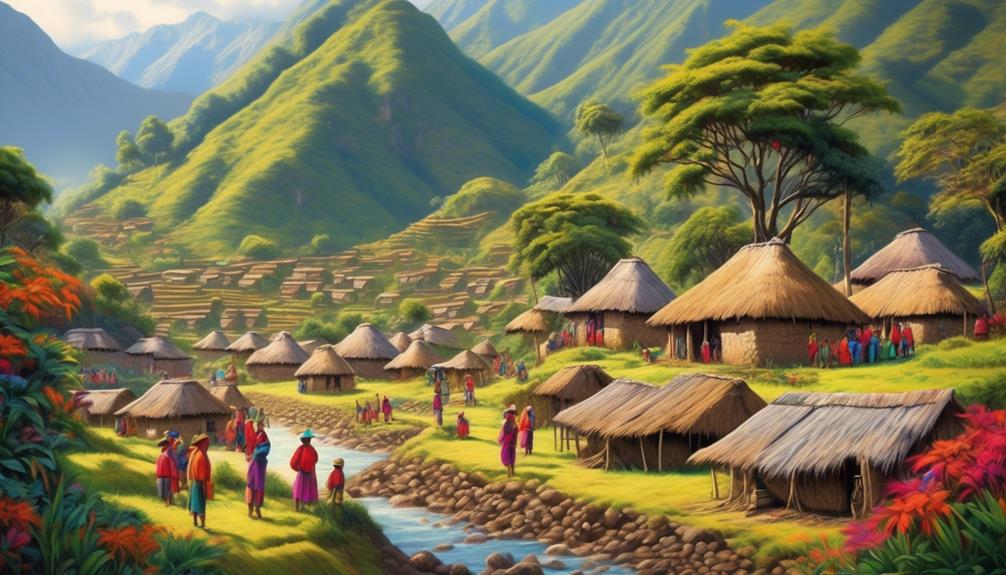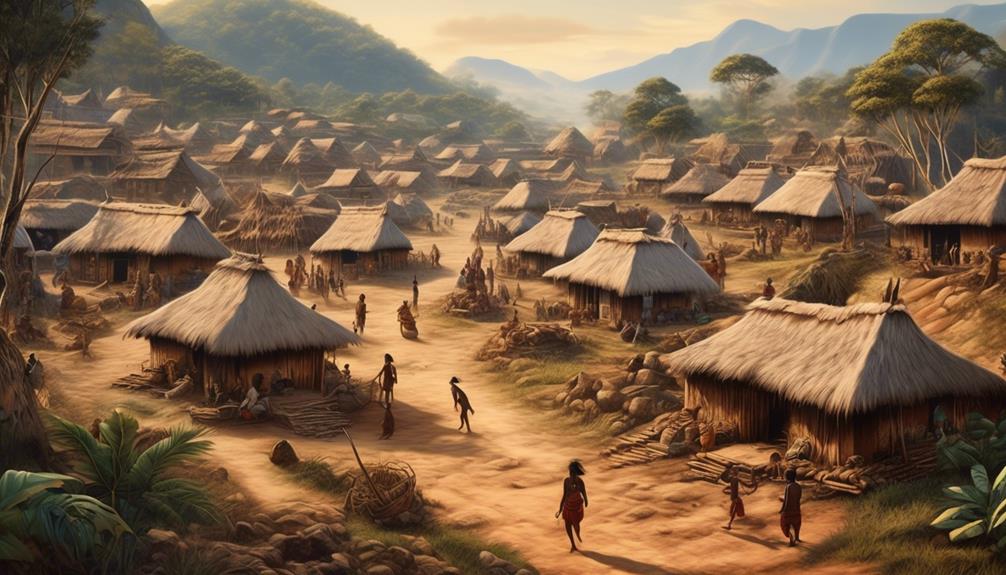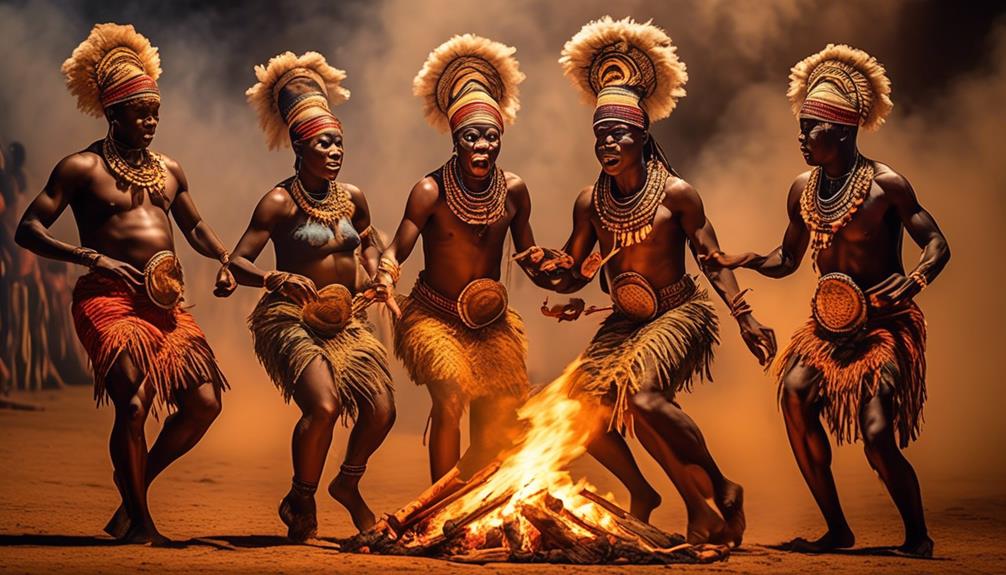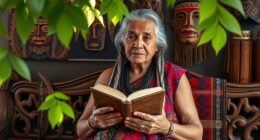When we think of Mexico, we often picture vibrant indigenous cultures alongside traces of Spanish colonial influence. The complex interaction between these two forces has significantly shaped the human geography of the region.
From the intricate social structures of pre-colonial indigenous societies to the enduring impact of Spanish conquest and colonial rule, the landscape of Mexico bears the indelible marks of these historical forces.
But how exactly has this dynamic interplay between colonialism and indigenous culture influenced the physical and cultural geography of Mexico, and what implications does it hold for the nation's future?
Key Takeaways
- Indigenous societies in Mexico had diverse cultures and practices that were shaped by their environment.
- The Spanish conquest and colonial rule imposed Spanish cultural and religious norms on indigenous societies, leading to cultural assimilation and erosion of indigenous languages and traditions.
- The Spanish conquest and colonial rule reshaped land use and settlement patterns, marginalizing traditional indigenous villages and disrupting indigenous land management practices.
- Mexico's cultural landscape reflects the fusion of indigenous and colonial traditions, with cultural syncretism leading to unique expressions of identity and ongoing efforts to protect and promote indigenous heritage.
Pre-Colonial Indigenous Societies
The pre-colonial indigenous societies of Mexico thrived in a diverse range of environments, from the arid deserts of the north to the lush jungles of the south, shaping their cultures and livelihoods according to the unique landscapes they inhabited. These societies developed rich cultural practices deeply intertwined with their surroundings.
In the north, desert-dwelling groups like the Yaquis and the Tarahumaras relied on irrigation systems to cultivate maize, beans, and squash, forming tight-knit social structures centered around agricultural cooperation. Meanwhile, in the south, the Maya, with their advanced understanding of astronomy and mathematics, constructed complex city-states in the heart of the jungle, where they practiced elaborate rituals and built towering pyramids to honor their deities.
Each of these societies had its own distinct social hierarchies, from the egalitarian structure of the Raramuris to the hierarchical system of the Aztecs, reflecting the diversity of cultural practices and beliefs across the region. These intricate social structures and cultural practices not only sustained these indigenous societies but also left a lasting imprint on the human geography of Mexico.
Spanish Conquest and Colonial Rule
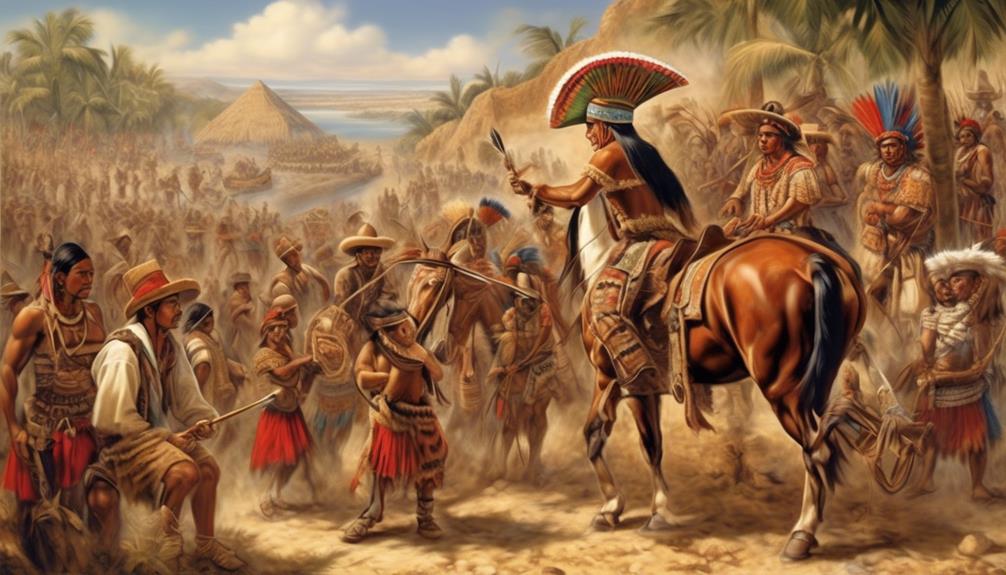
Upon encountering the rich cultural tapestry of pre-colonial indigenous societies in Mexico, the Spanish conquest and subsequent colonial rule heralded a profound and enduring transformation of the region's human geography. The Spanish conquest, led by Hernan Cortes in the early 16th century, marked the beginning of a new era for Mexico.
The conquest was characterized by the imposition of Spanish cultural and religious norms, which significantly impacted the indigenous societies. The power dynamics shifted drastically as the Spanish colonizers sought to assert their dominance, leading to the subjugation of the indigenous populations.
Cultural assimilation became a pivotal aspect of the colonial rule, as the Spanish attempted to integrate indigenous communities into the broader Spanish colonial framework. This process resulted in the blending of Spanish and indigenous cultural elements, giving rise to a complex and multifaceted societal landscape. The imposition of Spanish as the official language further reinforced this cultural assimilation, leading to the gradual erosion of indigenous languages and traditions.
The Spanish conquest and colonial rule not only reshaped the cultural identity of Mexico but also left an indelible mark on its human geography, shaping the societal structures and cultural dynamics that endure to this day.
Impact on Land Use and Settlement Patterns
Amidst the sweeping changes brought about by the Spanish conquest and colonial rule in Mexico, the impact on land use and settlement patterns reverberated across the region, reshaping the physical and cultural landscape.
The ways in which land was managed and utilized shifted dramatically, influencing the agricultural practices and productivity of the indigenous communities. The distribution of settlements underwent significant transformation, with new towns and cities being established while traditional indigenous villages were often marginalized or displaced.
Infrastructure development became a focal point for the colonial powers, leading to the construction of roads, bridges, and other vital transportation networks that facilitated trade and communication, altering the accessibility and connectivity of different regions.
Additionally, the introduction of new land ownership systems and property rights further disrupted traditional indigenous land management practices, leading to the consolidation of vast haciendas and the displacement of indigenous communities from their ancestral territories.
These changes left an enduring imprint on Mexico's human geography, shaping the land use and settlement patterns that are still evident today.
Cultural Syncretism and Heritage Preservation
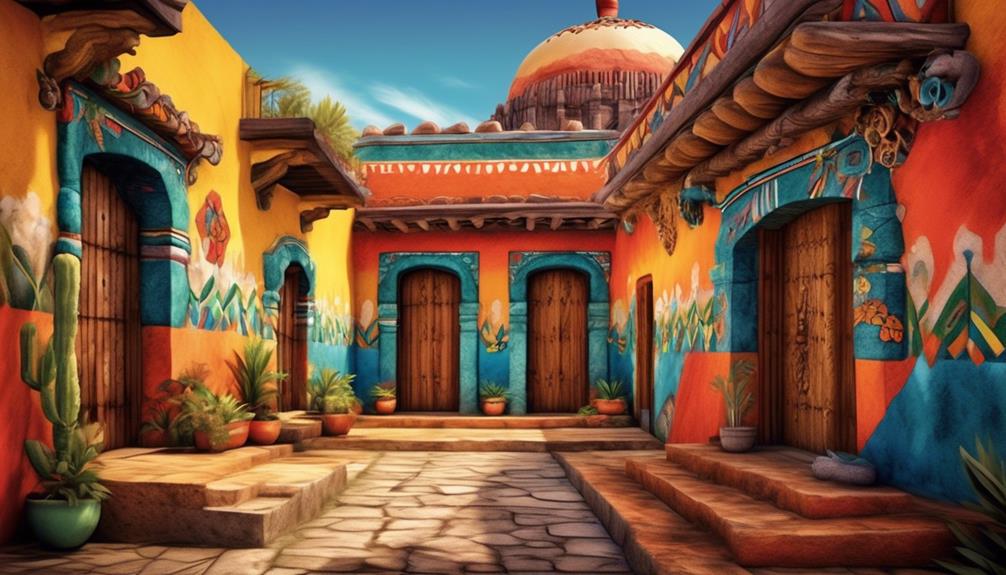
Experiencing the interplay of diverse cultural elements, Mexico's heritage undergoes a dynamic process of syncretism, shaping the contemporary identity of its indigenous communities. This cultural syncretism is a result of the historical interaction between indigenous traditions and colonial influences, leading to the creation of unique and multifaceted expressions of identity. While cultural assimilation has been a persistent challenge, indigenous communities have actively engaged in heritage preservation efforts to safeguard their ancestral practices and beliefs.
The concept of syncretism in Mexico's cultural landscape reflects the fusion of indigenous and colonial traditions, giving rise to a rich tapestry of customs, languages, and artistic expressions. This dynamic intermingling hasn't only influenced the daily lives of indigenous communities but also serves as a testament to their resilience and adaptability in preserving their distinct identities. Despite the pressures of globalization and modernization, efforts to protect and promote indigenous heritage continue to thrive, ensuring that future generations can inherit a legacy steeped in tradition and history.
In this complex interplay of cultural syncretism and heritage preservation, the indigenous communities of Mexico remain steadfast in their commitment to identity preservation, enriching the nation's cultural landscape with their enduring traditions and profound connection to the land.
Modern Challenges and Resilience
Facing contemporary challenges, indigenous communities in Mexico demonstrate remarkable resilience in preserving their cultural heritage and navigating the complexities of modernity.
In the midst of these challenges, their resilience is evident through:
- Cultural Adaptation: Indigenous communities have adeptly adapted to modern economic systems while retaining their traditional values and practices. This delicate balance allows them to participate in the global economy without compromising their cultural identity.
- Community Empowerment: Despite ongoing marginalization, indigenous communities have shown resilience by fostering community empowerment through education, activism, and sustainable development initiatives. This has enabled them to assert their rights and preserve their cultural heritage in the face of external pressures.
- Innovation and Creativity: Indigenous communities have displayed resilience by leveraging innovation and creativity to revitalize traditional crafts, agricultural practices, and cultural expressions. This not only sustains their cultural heritage but also provides economic opportunities in an ever-changing world.
The resilience of indigenous communities in Mexico serves as a testament to their enduring strength and adaptability in the face of modern challenges. Despite the obstacles they face, they continue to thrive and preserve their rich cultural heritage.
Frequently Asked Questions
What Are the Specific Indigenous Cultural Practices That Have Been Preserved and Integrated Into Modern Mexican Society?
We've seen how indigenous traditions in Mexico have been preserved and integrated into modern society, shaping its cultural landscape.
Specific practices such as traditional medicine, agricultural techniques, and artistic expressions have endured and influenced Mexican identity.
The cultural integration of indigenous beliefs and customs has enriched the country's heritage, contributing to its diversity and resilience.
These traditions continue to thrive, providing a link between the past and the present in Mexican society.
How Has Colonialism Affected the Distribution of Resources and Infrastructure in Mexico?
Colonialism has profoundly impacted resource distribution and infrastructure development in Mexico. The colonial powers exploited indigenous resources, creating an unequal distribution that still affects the country today.
Infrastructure development was primarily focused on serving colonial interests, leading to disparities in access to basic amenities.
Despite this, indigenous culture has persevered, integrating with modern society to shape Mexico's unique human geography.
What Are the Major Modern Challenges Faced by Indigenous Communities in Mexico, and How Are They Working to Overcome Them?
Challenges faced by indigenous communities in Mexico include resource access, discrimination, and cultural preservation. Empowerment initiatives focus on reclaiming traditional knowledge and adapting cultural practices for modern contexts.
Despite obstacles, communities are resilient, using their deep connection to the land and history to overcome challenges. This cultural adaptation strengthens their identity and promotes sustainable development.
Indigenous efforts reflect a dynamic blend of tradition and innovation, shaping Mexico's human geography in profound ways.
How Has the Concept of Land Ownership and Use Evolved From Pre-Colonial Times to the Present Day in Mexico?
Land ownership in Mexico has evolved dramatically, reflecting the rich tapestry of indigenous heritage and colonial influence.
From pre-colonial communal land use to the present-day blend of traditional practices and modern property rights, the cultural integration and preservation have shaped the landscape.
The intricate dance between indigenous customs and colonial legacies continues to define the evolution of land ownership, painting a vivid picture of Mexico's human geography.
What Role Do Indigenous Languages Play in Modern Mexican Society, and What Efforts Are Being Made to Preserve and Promote Them?
Indigenous languages are vital to modern Mexican society, reflecting rich cultural diversity.
Preservation efforts focus on documenting and promoting these languages, but modern challenges threaten their survival.
Cultural integration is essential for maintaining linguistic heritage.
Government initiatives support language education and community programs.
Collaborative efforts aim to ensure that indigenous languages continue to thrive in Mexico's evolving social landscape.
Conclusion
As we journey through Mexico's history, we see how colonialism and indigenous culture have woven a complex tapestry of human geography. Like a vibrant mosaic, the land bears the marks of conquest and resilience, shaping the very soul of the nation.
The interplay of tradition and modernity, hardship and triumph, has carved out a landscape that's as diverse and rich as the people who call it home. Mexico's geography is a living testament to the enduring spirit of its indigenous heritage.
Mary is a passionate writer who brings creativity and a fresh perspective to our team. Her words have the power to captivate and inspire, making her an essential contributor to our content. Mary’s commitment to storytelling and dedication to promoting Indigenous culture ensures that her work touches the hearts of our readers. We’re fortunate to have her as part of our team.
